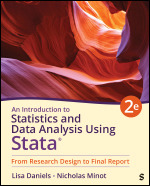An Introduction to Statistics and Data Analysis Using Stata®
From Research Design to Final Report
- Lisa Daniels - Washington College, USA
- Nicholas Minot - International Food Policy Research Institute, Washington, DC
Econometrics | Political Science Statistics | Quantitative/Statistical Research (General)
The Second Edition has been thoroughly updated with all new articles and data—including coverage of ChatGPT, COVID-19 policies, and SAT scores—to demonstrate the relevance of data analysis for students. A new chapter on advanced methods in regression analysis allows instructors to better feature these important techniques. Stata code has been updated to the latest version, and new exercises throughout offer more chances for practice.
Supplements
Online resources included with this text
The online resources for your text are available via the password-protected Instructor Resource Site, which offers access to all text specific resources, including a test bank, data sets, answer keys to exercises and homework problems, sample study guides, sample syllabus and course calendar, and tips for managing the grading load.
For additional information, custom options, or to request a personalized walkthrough of these resources, please contact your sales representative.
Author-created slides are available directly from the authors. To request these slides, please contact Lisa Daniels at LDaniels2@washcoll.edu or Nicholas Minot at N.Minot@gmail.com. These slides include smaller font sizes and provide more detailed information on each slide.
The book by Daniels and Minot helps students understand how to conduct empirical research. The authors' concise and straightforward approach makes complicated topics easy to grasp, while their emphasis on a hands-on experience approach utilizing Stata further enhances the practicality of the material.
An Introduction to Statistics and Data Analysis is a perfect example of a text that helps students learn how to use STATA and interpret statistical output! I often tell students that 'real' statisticians do not use paper and pencil or a graphing calculator to crunch numbers. We use STATA and this book integrates STATA into the learning process.
This textbook is a valuable resource for teaching students the basics of quantitative analysis with STATA. Its clear writing style ensures content accessibility. The simple explanations and practical examples maintain student engagement. Additionally, the book seamlessly integrates theoretical concepts with real-world applications, enhancing understanding and fostering critical thinking skills.
This is a great book for an undergraduate student population just getting into quantitative methods and STATA.
The writing is very clear and accessible, yet the statistical coverage is thorough enough for graduate students. The examples of how to use commands and how to interpret output are great references for students after they finish the course.
I LOVE how you use applied examples as I endeavor to do this every week for them and have found some great examples within this work! It brings the fun world of data analysis right to them so they can see why it is important. I think the authors also did a great job on varying topics across social science disciplines, not neglecting hardly a one anywhere—no room for improvement and only wish more analysis books did featuring so well.
Takes the approach we do that you have to start with good research methods, assumes no prior stat knowledge, focuses on the foundational basics that students 'already know' but don't really understand (this is a big strength of the book!), and teaches those basics in conjunction with Stata coding.
The second chapter offers a comprehensive guide on presenting students' research papers. It includes concrete examples illustrating each section of a research paper, making it particularly beneficial for students unfamiliar with this type of writing. Furthermore, the paper by Talan and Kalinkara (2023) on ChatGPT serves as a bridge between academic research and our daily lives. It highlights that academic knowledge, including what students learn from this book, is not separate from our everyday experiences.

